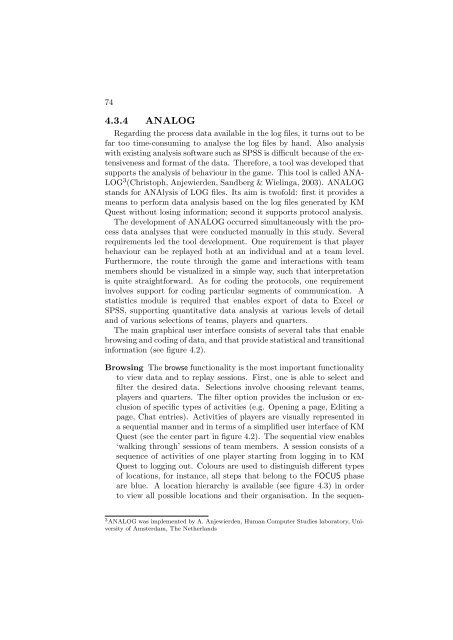The role of metacognitive skills in learning to solve problems
The role of metacognitive skills in learning to solve problems
The role of metacognitive skills in learning to solve problems
You also want an ePaper? Increase the reach of your titles
YUMPU automatically turns print PDFs into web optimized ePapers that Google loves.
74<br />
4.3.4 ANALOG<br />
Regard<strong>in</strong>g the process data available <strong>in</strong> the log files, it turns out <strong>to</strong> be<br />
far <strong>to</strong>o time-consum<strong>in</strong>g <strong>to</strong> analyse the log files by hand. Also analysis<br />
with exist<strong>in</strong>g analysis s<strong>of</strong>tware such as SPSS is difficult because <strong>of</strong> the extensiveness<br />
and format <strong>of</strong> the data. <strong>The</strong>refore, a <strong>to</strong>ol was developed that<br />
supports the analysis <strong>of</strong> behaviour <strong>in</strong> the game. This <strong>to</strong>ol is called ANA-<br />
LOG 3 (Chris<strong>to</strong>ph, Anjewierden, Sandberg & Wiel<strong>in</strong>ga, 2003). ANALOG<br />
stands for ANAlysis <strong>of</strong> LOG files. Its aim is tw<strong>of</strong>old: first it provides a<br />
means <strong>to</strong> perform data analysis based on the log files generated by KM<br />
Quest without los<strong>in</strong>g <strong>in</strong>formation; second it supports pro<strong>to</strong>col analysis.<br />
<strong>The</strong> development <strong>of</strong> ANALOG occurred simultaneously with the process<br />
data analyses that were conducted manually <strong>in</strong> this study. Several<br />
requirements led the <strong>to</strong>ol development. One requirement is that player<br />
behaviour can be replayed both at an <strong>in</strong>dividual and at a team level.<br />
Furthermore, the route through the game and <strong>in</strong>teractions with team<br />
members should be visualized <strong>in</strong> a simple way, such that <strong>in</strong>terpretation<br />
is quite straightforward. As for cod<strong>in</strong>g the pro<strong>to</strong>cols, one requirement<br />
<strong>in</strong>volves support for cod<strong>in</strong>g particular segments <strong>of</strong> communication. A<br />
statistics module is required that enables export <strong>of</strong> data <strong>to</strong> Excel or<br />
SPSS, support<strong>in</strong>g quantitative data analysis at various levels <strong>of</strong> detail<br />
and <strong>of</strong> various selections <strong>of</strong> teams, players and quarters.<br />
<strong>The</strong> ma<strong>in</strong> graphical user <strong>in</strong>terface consists <strong>of</strong> several tabs that enable<br />
brows<strong>in</strong>g and cod<strong>in</strong>g <strong>of</strong> data, and that provide statistical and transitional<br />
<strong>in</strong>formation (see figure 4.2).<br />
Brows<strong>in</strong>g <strong>The</strong> browse functionality is the most important functionality<br />
<strong>to</strong> view data and <strong>to</strong> replay sessions. First, one is able <strong>to</strong> select and<br />
filter the desired data. Selections <strong>in</strong>volve choos<strong>in</strong>g relevant teams,<br />
players and quarters. <strong>The</strong> filter option provides the <strong>in</strong>clusion or exclusion<br />
<strong>of</strong> specific types <strong>of</strong> activities (e.g. Open<strong>in</strong>g a page, Edit<strong>in</strong>g a<br />
page, Chat entries). Activities <strong>of</strong> players are visually represented <strong>in</strong><br />
a sequential manner and <strong>in</strong> terms <strong>of</strong> a simplified user <strong>in</strong>terface <strong>of</strong> KM<br />
Quest (see the center part <strong>in</strong> figure 4.2). <strong>The</strong> sequential view enables<br />
‘walk<strong>in</strong>g through’ sessions <strong>of</strong> team members. A session consists <strong>of</strong> a<br />
sequence <strong>of</strong> activities <strong>of</strong> one player start<strong>in</strong>g from logg<strong>in</strong>g <strong>in</strong> <strong>to</strong> KM<br />
Quest <strong>to</strong> logg<strong>in</strong>g out. Colours are used <strong>to</strong> dist<strong>in</strong>guish different types<br />
<strong>of</strong> locations, for <strong>in</strong>stance, all steps that belong <strong>to</strong> the FOCUS phase<br />
are blue. A location hierarchy is available (see figure 4.3) <strong>in</strong> order<br />
<strong>to</strong> view all possible locations and their organisation. In the sequen-<br />
3 ANALOG was implemented by A. Anjewierden, Human Computer Studies labora<strong>to</strong>ry, University<br />
<strong>of</strong> Amsterdam, <strong>The</strong> Netherlands
















